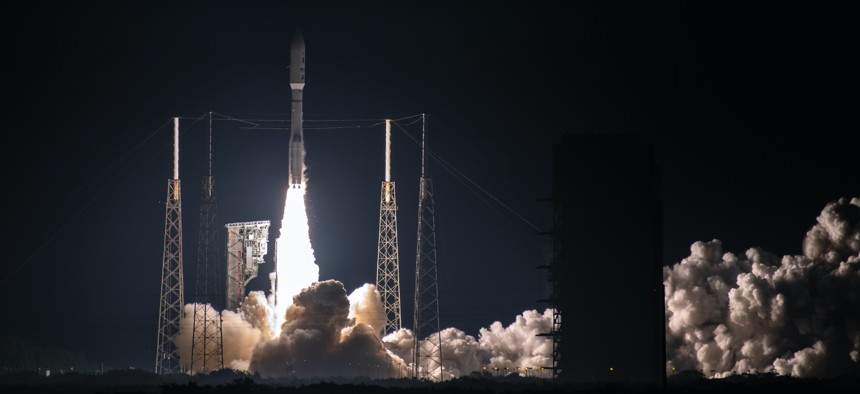
A United Launch Alliance Atlas V rocket lifts off Dec. 7, 2021, from Space Launch Complex 41 at Cape Canaveral Space Force Station, Fla. The rocket propelled two Department of Defense Space Test Program satellites into space. U.S. Space Force / Joshua Conti
Space Force Trying to Prep Old Satellites for New Threats by 2026
Russia and China are developing new space weapons faster than the U.S. can field new constellations. That’s forcing a big rethink on how to keep the lights on in space.
Russia and China are getting better at taking out U.S. satellites, so the Pentagon is reconsidering how it builds them, how it launches them, and how much it relies on commercial partners for both, a top Space Force official said Wednesday.
Two recent events illustrate the problem, said Lt. Gen. Michael Guetlein, who leads Space Systems Command, said at the C4ISR Conference in Arlington, Va.
In November, Russia used its Nudol missile to destroy a defunct, 3,860-pound "Cosmos 1408" satellite. Guetlein said the test created “several thousand pieces of debris” that, among other effects, sent astronauts on the International Space Station “scrambling into their escape capsules.” He called it a “demonstration of very unprofessional at least and very unsafe behavior in the way they look at space.”
In February, China tested a satellite that can grab and throw satellites. “That proves that they have the ability and the intent to compete against us for space superiority,” Guetlein said.
Current U.S. satellites weren’t designed to stand up to these kinds of assaults, which is why the Pentagon is working to have more resilient constellations in place by 2028: more satellites and ones that can defend themselves by maneuvering or other means.
But because Russian and Chinese anti-satellite capabilities are improving so quickly, the Space Force is also focusing on new ways to make current U.S. space capabilities harder to defeat, Guetlein said.
“What do we do between now and 2028? And that's really what we've been sounding the alarm on 2026…to get ready for either a crisis or a conflict that our nation depends absolutely on space. We need to take advantage of the resiliency that we can get into our current capabilities,” he said.
The military is spending “enormous amounts” to ensure “that in a crisis or conflict that we can guarantee exquisite [intelligence, surveillance and reconnaissance],” he said, “and investing in the resilience of those systems” in the 2023 defense budget proposal.
But a big part of it is just re-examining what some of the U.S. military’s decades-old satellites can do, and what private industry might be able to offer, to either make those old satellites more valuable or offset their loss in combat. The rapid rise of new commercial space enterprises is allowing the military to “fill gaps or even change our focus on the mission areas that the government was traditionally focused on [like providing lower-resolution satellite pictures or satellite based communication] to allow industry to take a piece of it while we focused on more exquisite capabilities in the denied areas going forward. So we are seeing an enormous amount of leverage being provided by our commercial industry across the board,” he said.




